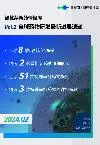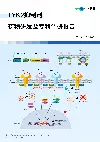The Next Wave of ADCs Could Treat Evasive Solid Tumors
上市批准抗体药物偶联物并购
Pictured: A pattern of ADCs, tumors and IV bags/Taylor Tieden for BioSpace
Advances in antibody-drug conjugates, including novel payloads and new targets, will be featured at the American Association for Cancer Research's annual conference, taking place this week in San Diego, where companies, including Elevation Oncology and Tubulis, will present new data from their respective programs.
The first antibody-drug conjugate (ADC) was approved by the FDA nearly 25 years ago for acute myeloid leukemia, and other early approvals similarly targeted blood cancers. But today, ADCs offer a formidable treatment option for solid tumors, which Elevation Oncology CSO David Dornan said “are almost equally as hard [as each other] and different in their own right because it’s an epithelial cell [which] have just created this amazing way of dealing with multiple drugs resistance.” Six of the 11 ADCs now on the market are for solid tumors, and next-generation approaches are enabling drug developers to target the most difficult-to-treat cancers.
“ADCs kind of originated in the liquid tumor space, but all of the excitement now is around the solid tumor space,” Nathan Tumey, associate professor at the School of Pharmacy and Pharmaceutical Sciences at Binghamton University, told BioSpace.
The Next Generation
ADCs combine the selectivity of monoclonal antibodies with the potency of cytotoxic small molecules. The two are connected with a stable linker. With the market for ADCs set to hit $30 billion by 2028, drug developers are investing in strategies and technology to fine-tune all three components.
ADCs are currently in the second generation of development, said Jake Van Naarden, president of Eli Lilly’s Loxo Oncology division, “and I think the third is coming.” In the first generation, “you didn’t have a lot of sophistication about payload classes” and other factors such as bystander effects, which occur when the drug kills neighboring cells that may or may not express the target antigen. The second generation is “much more intentional about those choices,” including class of payload, class of chemotherapy and whether or not to seek a bystander effect, he said.
One new payload class that is attracting attention is topoisomerase inhibitors, which have demonstrated an increased therapeutic window compared to microtubule inhibitors, which had been more common, Tumey said. “That’s really been kind of the fundamental shift in the field.”
Currently approved therapies using topoisomerase inhibitors are Gilead’s Trodelvy and Daiichi Sankyo and AstraZeneca’s Enhertu. Tumey said that Enhertu, first approved in 2019 for HER2-positive breast cancer after showing an objective response rate of 60.3% and median duration of response of 14.8 months, has driven a lot of the excitement in this modality.
AstraZeneca and Daiichi Sankyo are developing a new TROP2-targeted ADC called datopotamab deruxtecan (Dato-DXd), and in February, the FDA accepted their Biologics License Application (BLA) in second-line non-small cell lung cancer, setting a target action date of Dec. 20, 2024. An approval would “further validate this topoisomerase technology,” Tumey said. The FDA also accepted the BLA for Dato-DXd in hormone receptor-positive, HER2-negative breast cancer last week and set a PDUFA date of Jan. 29, 2025.
Topoisomerase inhibitors are just the tip of the iceberg when it comes to new ADC payloads, but their success has “spurred interest in kind of next-generation payloads,” Tumey said. He added that researchers now have an improved understanding of the potency required. “There was a time when everybody thought, hey, the more potent the better, and I think we’ve kind of learned our lesson there that some moderate potency payloads seem to be really an ideal space.”
Some companies are even looking to develop ADCs with more than one payload. Dornan told BioSpace that optionality—either via an ADC with two different payloads targeting two different antigens on the same tumor or one ADC with multiple payloads conjugated with different mechanisms of action—is important. “Dual payloads,” he predicted, “are going to become hopefully the new flavor of ADCs.”
Dornan said novel payloads will continue to be a part of ADC advancement, with protein degraders and enzyme inhibitors among those being tried. “You’re now creating a menu of optionality for patients. As the ADC field has evolved, we’re developing tools to be able to deliver something that has . . . become more impactful, and hopefully drive toward those long-lasting remissions.”
Beyond the Payload
Mark Rutstein, SVP and head of oncology clinical development at Daiichi Sankyo, told BioSpace that linker technology and cleavability are also important factors in developing a successful ADC, as well as the degree to which the molecule triggers the bystander effect. “Certainly, the payload’s a component, but that’s only one piece,” he said.
Kristin Bedard, vice president of biologics at Loxo Oncology, agreed that linker stability is an important aspect of next-generation ADCs. The class has been plagued in the clinic by duration of treatment response because patients are unable to stay on the drugs due to severe side effects, she said. Because the ADCs are not completely stable, chemotherapy can fall off in the bloodstream, she explained. “A lot of the [toxicity] that we see in the clinic is just payload” that is released systemically, outside of the tumor.
This has been a big focus for Lilly, Bedard said, and a driver of the company’s October 2023 acquisition of Mablink Bioscience. Mablink’s PSARLink technology lends better stability by shielding the payload when it’s in circulation, allowing for more tumor selective release, she explained.
Dominik Schumacher, CEO of Munich-based biotech Tubulis, said that duration of response is another area where ADCs “can do even better.” Tubulis’s platform is predicated on flexibility in designing ADCs, Schumacher told BioSpace, linking different payloads with various conjugation methods to an assortment of linkers and adjusting the drug-to-antibody ratio. It’s this flexibility that has led to preclinical success, he said. “We really enable a very long-lasting delivery of payload to the tumor, and we see that in preclinical models we have extremely long durability—much longer than we’ve seen for other molecules.” Schumacher acknowledged that these data will need to be replicated in the clinic.
Van Naarden said the third generation is still “to be defined,” but
speculated that it could include “a whole host of
payload ideas,” as well as approaches targeting more than one
tumor antigen to achieve greater tumor specificity.
Tackling the Toughest Tumors
Despite the “unbelievable step-function change in outcomes for patients” that a variety of new medicines have brought to the solid tumor space, Van Naarden said, “there are a couple of types of solid tumors that have sort of been left behind.” These include colon cancer, pancreatic cancer and gastric cancer, indications for which there is still a great unmet need.
Elevation is developing EO-3021, a Claudin 18.2 ADC, for gastric and gastroesophageal junction (GEJ) cancers, among other solid tumors likely to express CLDN18.2.
Alongside Dato-DXd, Daiichi Sankyo, partnered with Merck, is developing I-DXd and R-DXd, targeting small cell lung cancer and platinum-resistant ovarian cancer—both difficult-to-treat cancers, Rutstein said. Both candidates are heading into pivotal trials, he added. Tubulis is also targeting ovarian cancer, along with non-small cell lung cancer, with its lead preclinical asset, TUB-040.
“There are still unmet needs in solid tumor oncology, and that’s clear, but we are making inroads,” Rutstein said.
Van Naarden concurred. “There’s a lot of work we as a field need to do to improve outcomes for those patients,” he said. “I think ADCs will be a part of that.” But it likely won’t be all of it, he added. Lilly has diversified its approaches because “I don’t know that we’re, as a field, smart enough about the human biology of cancer to bet on one thing.”
Heather McKenzie is a senior editor at BioSpace. You can reach her at heather.mckenzie@biospace.com. Also follow her on LinkedIn.
更多内容,请访问原始网站
文中所述内容并不反映新药情报库及其所属公司任何意见及观点,如有版权侵扰或错误之处,请及时联系我们,我们会在24小时内配合处理。
立即开始免费试用!
智慧芽新药情报库是智慧芽专为生命科学人士构建的基于AI的创新药情报平台,助您全方位提升您的研发与决策效率。
立即开始数据试用!
智慧芽新药库数据也通过智慧芽数据服务平台,以API或者数据包形式对外开放,助您更加充分利用智慧芽新药情报信息。





